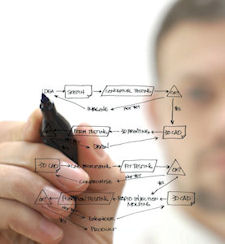Prototyping Processes: Choosing the Best Process for Your Project

Latest News
February 3, 2015
 Dear Desktop Engineering Reader:
Dear Desktop Engineering Reader:
Additive manufacturing, machining and molding technologies for rapid prototyping or low-volume production come in all sorts of varieties. Choosing the right technology for your needs can leave you feeling as unsure as a high-wire performer with a sudden leg cramp. That’s OK. You’re probably more familiar with design, not prototyping hardware. What you need is a guide that summarizes the technologies, their materials and ideal usages so that you can make an informed decision when picking the process for your job. That’s what you’ll find at the other end of today’s Check it Out link.
“Prototyping Processes: Choosing the Best Process for Your Project” is an 11-page PDF reference guide to prototyping and manufacturing processes created by quick-turnaround manufacturing service provider Proto Labs. It is simply terrific.
 Proto Labs offers at least eight additive manufacturing, machining and molding technologies: CNC (computer numerically controlled) machining, DMLS (direct metal laser sintering), FDM (Fused Deposition Modeling), injection molding, PolyJet 3D printing, SLS (selective laser sintering), stereolithography and 3DP (three-dimensional printing). The paper explains each technology and compares it to the others. It does so in a manner that works for the new kid in town, the old pro and everyone in between.
Proto Labs offers at least eight additive manufacturing, machining and molding technologies: CNC (computer numerically controlled) machining, DMLS (direct metal laser sintering), FDM (Fused Deposition Modeling), injection molding, PolyJet 3D printing, SLS (selective laser sintering), stereolithography and 3DP (three-dimensional printing). The paper explains each technology and compares it to the others. It does so in a manner that works for the new kid in town, the old pro and everyone in between.
“Prototyping Processes” begins with a quick comparison chart of prototyping processes. It’s like a spec sheet: a brief description of the process, its range of material strength, finish quality and examples of available materials. So, for DMLS you have: Laser-sintered metal powder; 37,700 - 190,000 (psi); additive layers 0.0008 - 0.0012 in. typical; and stainless steel, titanium, chrome, aluminums and Inconel. That’s it. Short and sweet, perfect for anyone experienced with the technologies but not willing to rely on memory when selecting a process.
A long section called “Process Comparisons for Prototyping Options” is next. This discussion is useful for everyone, but it will be particularly valuable for designers with scant or no experience with prototyping technologies. The order of presentation follows that of the introductory chart. The details, however, are far richer.
What you’ll find here are brisk summaries of how each technology operates and the material properties of parts it produces. An accompanying image gives you a glimpse of a part’s appearance. The nice thing here is that each technology has a pros and cons blurb. For example, the pros of injection molding include the ability to mold parts from an array of engineering-grade materials. On the other hand, the cost of tooling can make front-end costs a lot higher.
Before wrapping it up, “Prototyping Processes” provides two quick charts and a list of definitions. Each of these all readers should find extremely helpful.
Chart one is a decision tree. It focuses on three key details you need to consider before you commit to a prototyping process: The current stage of your project, your most important factors and attributes. Stage means things like concept modeling or regulatory testing. Factors encompass form, mechanical properties and so on. Attributes covers part characteristics like materials, color and complexity.
The second chart is reminiscent of an infographic from Consumer Reports. It provides a comparison rating (poor, fair and good) of prototype attributes. It also includes a rating for low- and high-volume production pricing. The definition list of keywords used in the charts and throughout document helps keep everyone on the same page.
The beauty of “Prototyping Processes: Choosing the Best Process for Your Project” is that Proto Labs has expertise in each of the technologies covered, enabling it to provide an even-handed account of each technology’s strengths and weaknesses. The paper’s goal is to help you commit to the prototyping process or low-volume production technology best suited for your product development needs. Whether it succeeds or not is up to you, of course, but it seems unlikely that you’re going to find a better quick reference piece than this paper. Hit today’s Check it Out link, download your complimentary copy and see for yourself.
Thanks, Pal. – Lockwood
Anthony J. Lockwood
Editor at Large, Desktop Engineering
Download “Prototyping Processes: Choosing the Best Process for Your Project” here.
Subscribe to our FREE magazine, FREE email newsletters or both!
Latest News
About the Author
Anthony J. Lockwood is Digital Engineering’s founding editor. He is now retired. Contact him via [email protected].
Follow DERelated Topics






